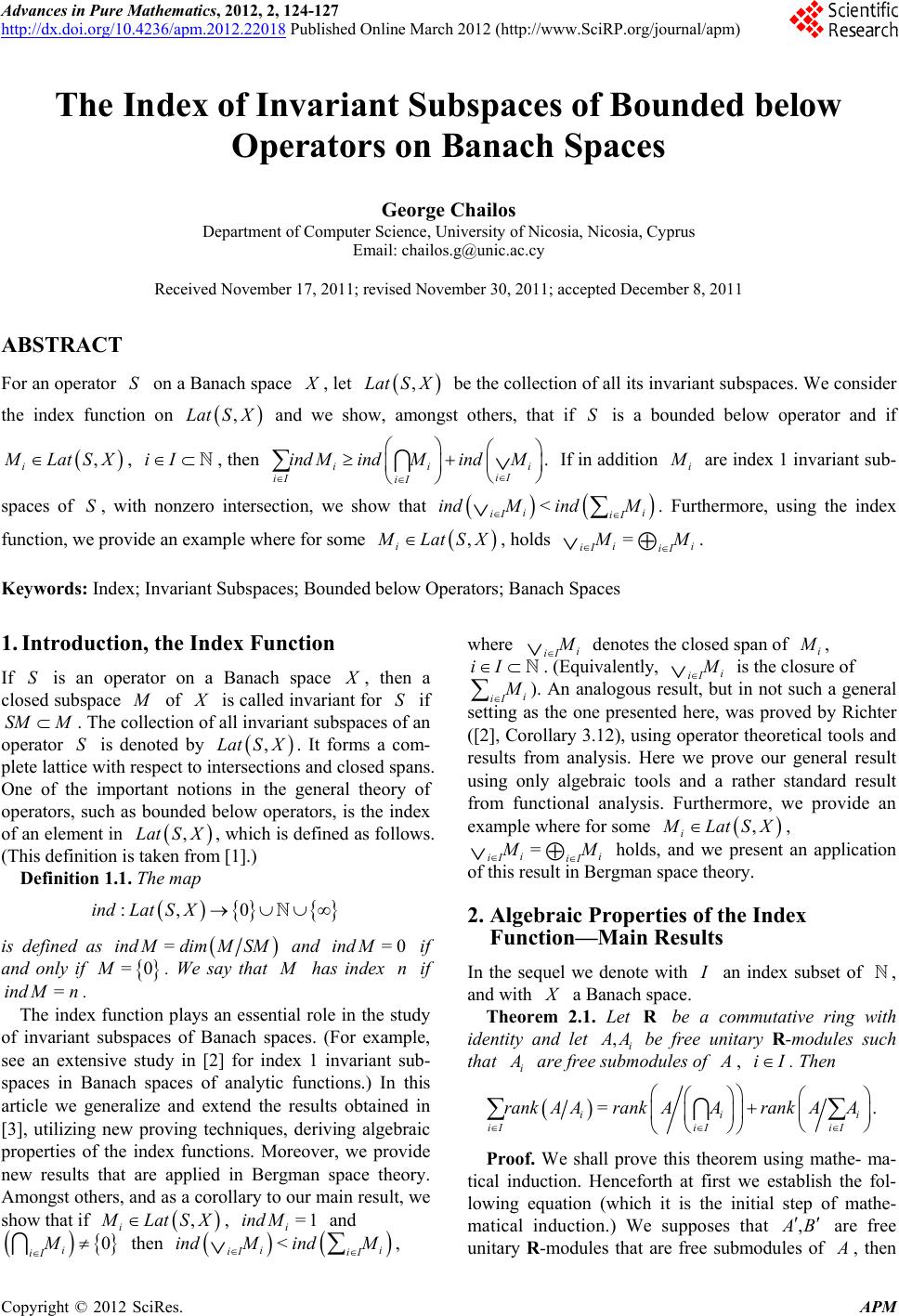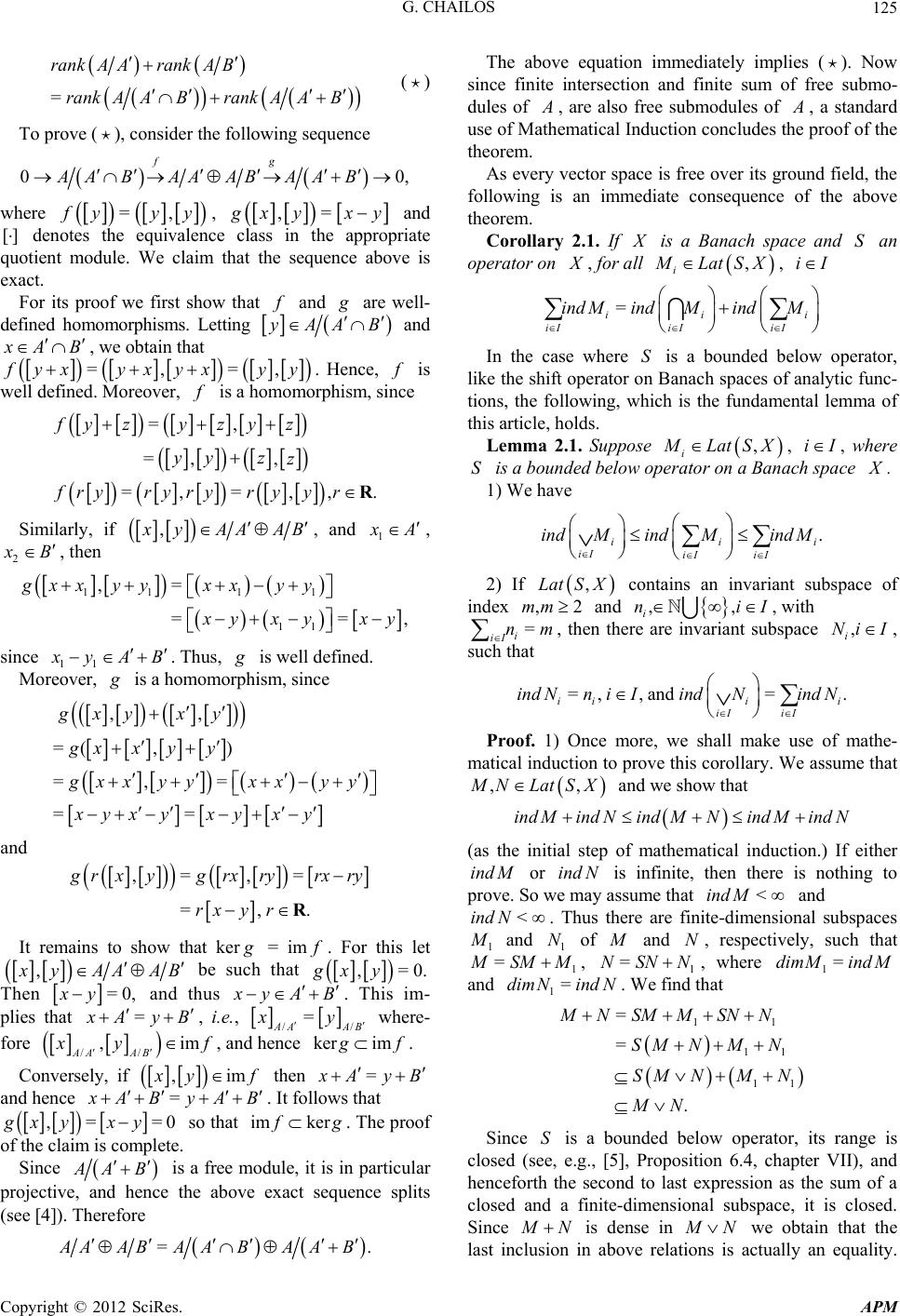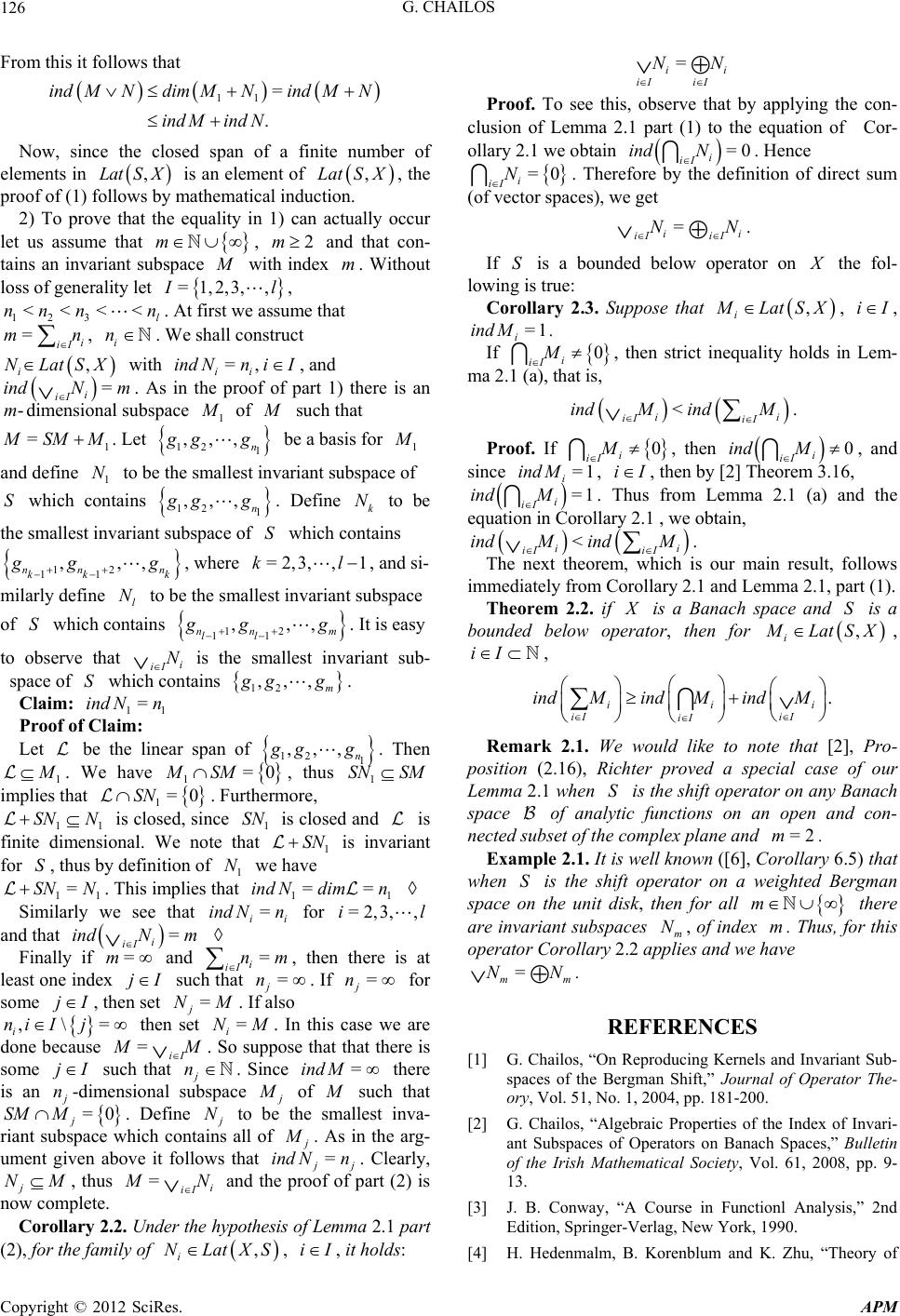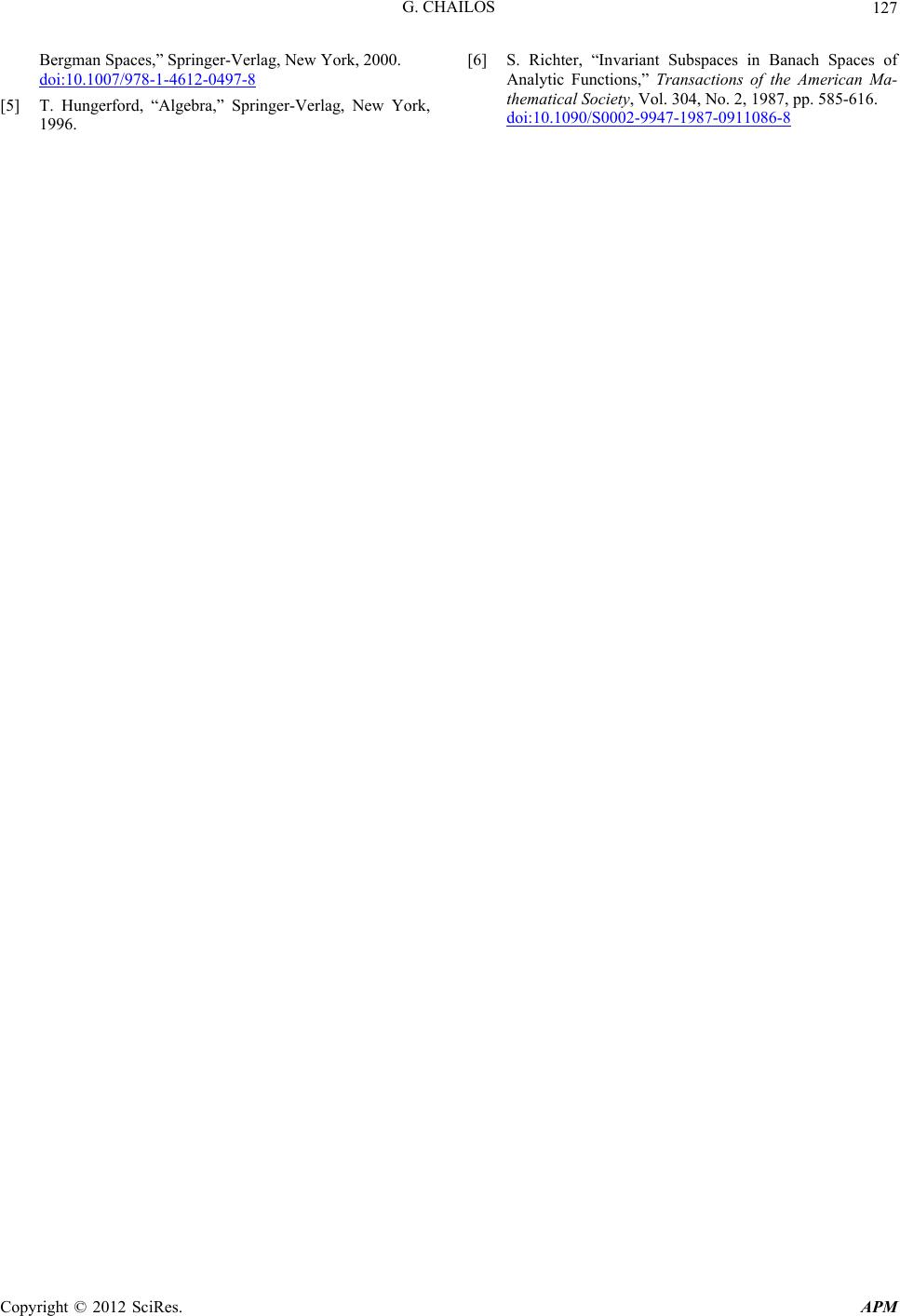 Advances in Pure Mathematics, 2012, 2, 124-127 http://dx.doi.org/10.4236/apm.2012.22018 Published Online March 2012 (http://www.SciRP.org/journal/apm) The Index of Invariant Subspaces of Bounded below Operators on Banach Spaces George Chailos Department of Computer Science, University of Nicosia, Nicosia, Cyprus Email: chailos.g@unic.ac.cy Received November 17, 2011; revised November 30, 2011; accepted December 8, 2011 ABSTRACT For an operator on a Banach space S , let ,LatS X S be the collection of all its invariant subspaces. We consider the index function on and we show, amongst others, that if is a bounded below operator and if ,S X Lat , i LatS X, , then If in addition iI ii iI ind M . iI in M i iI indM d i are index 1 invariant sub- spaces of , with nonzero intersection, we show that S i iI M <Mi ind iI ind . Furthermore, using the index function, we provide an example where for some , i LatS X= ii iI iI , holds M . Keywords: Index; Invariant Subs paces; Bounded below Operators; Banach Spaces 1. Introduction, the Index Function If is an operator on a Banach space S , then a closed subspace of is called invariant for if . The collection of all invariant subspaces of an operator is denoted by S SM M S ,LaXt S. It forms a com- plete lattice with respect to intersections and closed spans. One of the important notions in the general theory of operators, such as bounded below operators, is the index of an element in ,LatS X, which is defined as follows. (This definition is taken from [1].) Definition 1.1. The map 0:,indLatS X is defined as =indM =0Mdim MSM=0dM and in if and only if . We say that has index if . n =indM n The index function plays an essential role in the study of invariant subspaces of Banach spaces. (For example, see an extensive study in [2] for index 1 invariant sub- spaces in Banach spaces of analytic functions.) In this article we generalize and extend the results obtained in [3], utilizing new proving techniques, deriving algebraic properties of the index functions. Moreover, we provide new results that are applied in Bergman space theory. Amongst others, and as a corollary to our main result, we show that if , i LatS Xind , and then , =1 ii iI nd M i indM < iI M i 0 i iI M where i iI i , denotes the closed span of iI . (Equivalently, i iI i iI is the closure of ). An analogous result, but in not such a general setting as the one presented here, was proved by Richter ([2], Corollary 3.12 ), using operato r theoretical tools and results from analysis. Here we prove our general result using only algebraic tools and a rather standard result from functional analysis. Furthermore, we provide an example where for some i , LatS X =, ii iI iI M holds, and we present an application of this result in Bergman space theory. 2. Algebraic Properties of the Index Function—Main Results In the sequel we denote with an index subset of , and with a Banach space. Theorem 2.1. Let be a commutative ring with identity and let i R , A i be free unitary R-modules such that are free submodules of , . Then iI =. iii iI iI iI rankAArank AArank AA , Proof. We shall prove this theorem using mathe- ma- tical induction. Henceforth at first we establish the fol- lowing equation (which it is the initial step of mathe- matical induction.) We supposes that B are free unitary R-modules that are free submodules of , then C opyright © 2012 SciRes. APM  G. CHAILOS 125 A AB = rankA ArankAB rank AABrank () To prove (), consider the following sequence 0 fg AA BAAABA 0,A B where =, yyy , ,= xy xy and denotes the equivalence class in the appropriate quotient module. We claim that the sequence above is exact. [] For its proof we first show that and are well- defined homomorphisms. Letting AA B and AB , we obtain that =,= , yx yxyxy y. Hence, is well defined. Moreover, is a homomorphism, since =, =,, =,= fy zy zy yy z fryryry r ,,. z z yy r R Similarly, if , yAAAB 1 , and A , 2 B , then 111 11 ,=gxx yyxxy 1 == , y yx y xy since 11 yA B . Thus, is well defined. Moreover, is a homomorphism, since ,, =( ,) =,= == gxy xy gxx yy xx yyxx xyx yxy yy x y and ,= , =, = . rxyg rxry rx y rx ry r R It remains to show that ker = im . For this let , yAAAB be such that ,=0.gx y Then =0,xy and thus yA B . This im- plies that = Ay B, i.e., / = AA x /AB y where- fore AA i //AB , m yfker im, and hence f. Conversely, if im, yf then = AyB = and hence AB yAB . It follows that ,=gx yxy=0 so that im ker g . The proof of the claim is complete. Since AB is a free module, it is in particular projective, and hence the above exact sequence splits (see [4]). Therefore =. AABAAB AAB The above equation immediately implies (). Now since finite intersection and finite sum of free submo- dules of , are also free submodules of , a standard use of Mathematical Induction concludes the proof of the theorem. As every vector space is fr ee over its ground field, the following is an immediate consequence of the above theorem. Corollary 2.1. If is a Banach space and an operat o r o n S , i , for all LatS XiI = ii i iI iI iI indM indMindM S , , In the case where is a bounded below operator, like the shift operator on Banach spaces of analytic func- tions, the following, which is the fundamental lemma of this article, holds. Lemma 2.1. Suppose iLatS XiI, , where is a bo u n ded below operator on a Ba nach space . S1) We have . iii iI iI iI indMindMindM 2) If ,LatS X ,2mm ,,niI contains an invariant subspace of index and i =nm , with i iI , then there are invariant subspace , i Ni I , such that =, ,and=. iii i iI iI ind NniIindNind N Proof. 1) Once more, we shall make use of mathe- matical induction to prove this corollary. We assume that ,, NLatSX and we show that indMindNindMNindMind N indMind N<indM <ind N (as the initial step of mathematical induction.) If either or is infinite, then there is nothing to prove. So we may assume that and . Thus there are finite-dimensional subspaces 1 and of 1 N and , respectively, such that N 1 = SM M , 1 =NSNN , where and . We find that 1=dimM indM 1=dimNind N 11 11 11 = = . MNSMM SNN SM NMN SM NMN MN S Since is a bounded below operator, its range is closed (see, e.g., [5], Proposition 6.4, chapter VII), and henceforth the second to last expression as the sum of a closed and a finite-dimensional subspace, it is closed. Since N is dense in N we obtain that the last inclusion in above relations is actually an equality. Copyright © 2012 SciRes. APM  G. CHAILOS 126 From this it follows that 11 = . indMNdim MN indMind N ind MN ,LatSX ,LatS X Now, since the closed span of a finite number of elements in is an element of , the proof of (1) follows by mathematical induction. 2) To prove that the equality in 1) can actually occur let us assume that 2mm, and that con- tains an invariant subspace with index . Without loss of generality let m 2 ,=1,,3, l i iI mn i n NL=,Nn iI 1 , . At first we assume that 123 <<<<nl nnn =, . We shall construct ,atSX ind = i iI N m i in m with ii , and . As in the proof of part 1) there is an dimensional subspace d - of such that 1 = SM M. Let 12 1 ,,, n gg1 be a basis for and define to be the smallest invariant subspace of 1 N S12 ,, which contains 1 , n gk N 12 11 ,, g S . Define to be the smallest invariant subspace of which contains , n k nn kk g =2,3,,1kl N S 12 11 ,,, m ll g, where , and si- milarly define to be the smallest invariant subspace l nn of which contains gg N S . It is easy to observe that i iI is the smallest invariant sub- space of which contains 12 ,,, m gg ind 1 ,,, n . Claim: 11 Proof of Claim: =N n Let be the linear span of 12 gg. Then 1 1 SN SM 11 ==m n . We have , thus implies that . Furthermore, 11 is closed, since 1 is closed an d is finite dimensional. We note that 1 is invariant for , thus by definitio n of 1 we have . This implies that 1=0MSM 1=0 SN Nind SN N di SN N =N SN S SN 11 Similarly we see that for and that = ii d Nn =nm in =2,3,,il = j n = i iI N m =m ind Finally if and i iI , then there is at least one index such that j n. If jI= for some , then set j. If also i then set i. In this case we are done because iI j j I = = =NM =NM,\Ini M . So suppose that that there is some such that j. Since Inj =indM there is an n-dimensional subspace of such that j. Define =0SM M N to be the smallest inva- riant subspace which contains all of . As in the arg- ument given above it follows that = j. Clearly, j, thus ind Nn N M=iI i N and the proof of part (2) is now complete. Corollary 2.2. Under the hypothesis of Lemma 2.1 part (2), for the family of ,tXS iI = ii iI iI NN i NLa, , it holds: Proof. To see this, observe that by applying the con- clusion of Lemma 2.1 part (1) to the equation of Cor- ollary 2.1 we obtain =0ind N i iI. Henc e =0N = ii iI iI NN S i iI. Therefore by the definition of direct sum (of vector spaces), we get . If is a bounded below operator on the fol- lowing is true: , i Corollary 2.3. Suppose that LatS XiI, , . =1 i indM If 0M i iI, then strict inequality holds in Lem- ma 2.1 (a), that is, < ii iI iI indM indM . 0 i iI M 0ind M, then i iI Proof. If =1 i indM iI , and since , , then by [2] Theorem 3.16, =1ind M i iI. Thus from Lemma 2.1 (a) and the equation in Corollary 2.1 , we obtain, <indMindM ii iI iI . The next theorem, which is our main result, follows immediately from Corollary 2.1 and Lemma 2.1, part (1). Theorem 2.2. if is a Banach space and is a bounded below operator, then for S , i LatS X iI , . iii iI iI iI indMind MindM S =2m S , Remark 2.1. We would like to note that [2], Pro- position (2.16), Richter proved a special case of our Lemma 2.1 whe n is the shift operator on any Banach space of analytic functions on an open and con- nected subset of the complex plane and . Example 2.1. It is well known ([6], Corollary 6.5) that when is the shift operator on a weighted Bergman space on the unit disk, then for all m Nm = mm NN there are invariant subspaces m, of index . Thus, for this operator Corollary 2.2 applies and we have . REFERENCES [1] G. Chailos, “On Reproducing Kernels and Invariant Sub- spaces of the Bergman Shift,” Journal of Operator The- ory, Vol. 51, No. 1, 2004, pp. 181-200. [2] G. Chailos, “Algebraic Properties of the Index of Invari- ant Subspaces of Operators on Banach Spaces,” Bulletin of the Irish Mathematical Society, Vol. 61, 2008, pp. 9- 13. [3] J. B. Conway, “A Course in Functionl Analysis,” 2nd Edition, Springer-Verlag, New York, 1990. [4] H. Hedenmalm, B. Korenblum and K. Zhu, “Theory of Copyright © 2012 SciRes. APM  G. CHAILOS Copyright © 2012 SciRes. APM 127 Bergman Spaces,” Springer-Verlag, New York, 2000. doi:10.1007/978-1-4612-0497-8 [5] T. Hungerford, “Algebra,” Springer-Verlag, New York, 1996. [6] S. Richter, “Invariant Subspaces in Banach Spaces of Analytic Functions,” Transactions of the American Ma- thematical Society, Vol. 304, No. 2, 1987, pp. 585-616. doi:10.1090/S0002-9947-1987-0911086-8
|